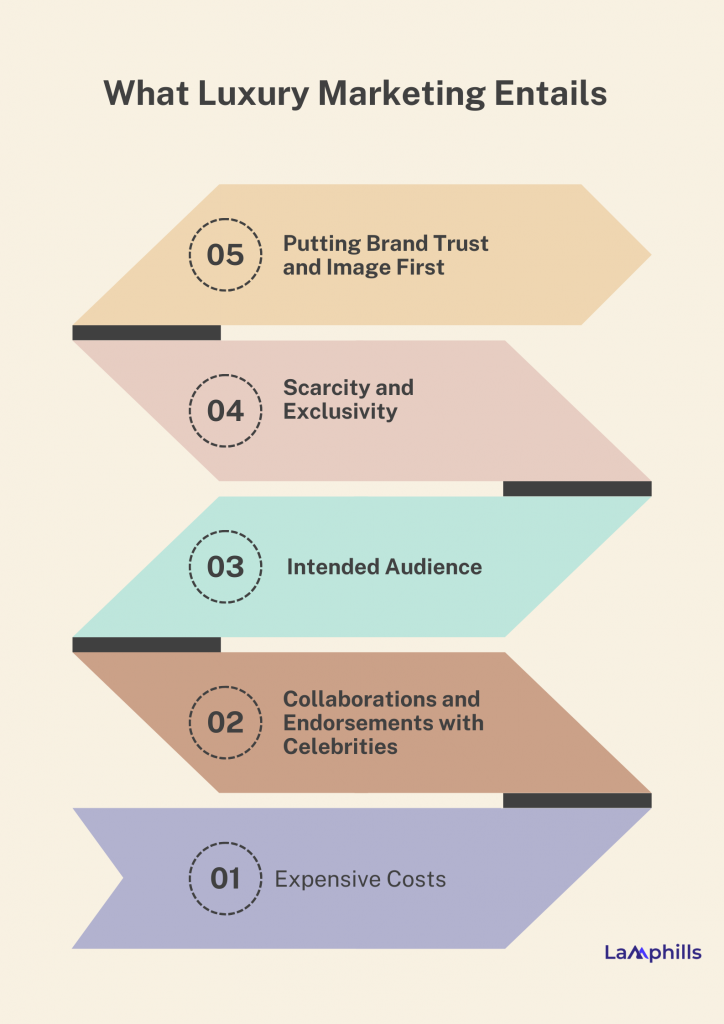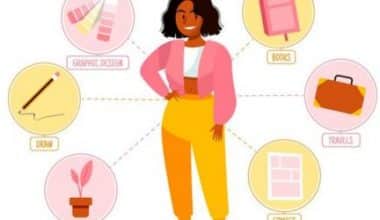I am sure you have noticed that most buyers who prefer high-end luxury purchases allow their decisions to be freely influenced by product uniqueness, beauty, and quality (mostly quality). These factors can be leveraged to develop marketing efforts that appeal to these consumers to effectively promote the products. By doing this, you can ensure that your business and its offerings attract attention from the right customers and generate more income.
This is what luxury marketing is all about at the most basic level. But when do you employ this type of marketing, and what strategies should you implement if you have a high-end product line?
In this article, I will explain, in detail, what luxury marketing means, go over common tactics and strategies, and show you how to target your demographic directly.
Key Takeaways
- Luxury marketing focuses on creating an emotional experience and lifestyle appeal, emphasizing product uniqueness, quality, and exclusivity rather than just selling high-end goods.
- Successful luxury marketing strategies often include high pricing, celebrity collaborations, targeting high-net-worth individuals, maintaining brand image, and creating a sense of scarcity.
- To become a luxury brand marketer, it’s important to network at industry events, gain deep sector knowledge, consider specialized education, and build a strong portfolio showcasing relevant skills.
- Effective luxury marketing tactics include creating user-friendly websites, leveraging influencer partnerships, implementing SEO best practices, utilizing social media, and developing targeted email campaigns.
- Luxury brands should focus on storytelling, creating exclusive experiences, and understanding their segmented audience to develop personalized marketing approaches that resonate with sophisticated consumers.
What Is Luxury Brand Marketing?
Luxury marketing is different from normal marketing in several important ways. Simply put, the marketing techniques used to promote luxury goods and services cater to a distinct set of customer expectations and wishes.
What Luxury Marketing Entails
Luxury marketing uses promotional programs to offer high-end, pricey products to consumers. It varies from traditional marketing in that it targets a consumer who often earns a higher income and buys items for enjoyment rather than need or to address a problem.
For the most part, designer clothing, jewellery, and pricey cars are common examples of luxury merchandise. And because you’re selling to a specific demographic, your marketing efforts must cater to their tastes, personalities, and purchasing habits.

Among the principal variations are:
#1. Expensive Costs
Pricing itself can occasionally be used as a marketing ploy. Luxury brands use their exorbitant costs to project an air of prestige. On the other hand, customers find this appealing because they are willing to pay more for the bragging rights associated with scarcity.
Because wealthy customers might also be price-sensitive, hazards are associated with this method.
#2. Collaborations and Endorsements with Celebrities
Luxury firms can increase product desirability and promote their items by collaborating with influencers and celebrities. Enhancing and bringing to life particular brand attributes has always required partnerships and endorsements. However, the proliferation of marketing media platforms has complicated the administration of celebrity endorsements, requiring firms to
#3. Intended Audience
High-net-worth individuals (HNWI) and aspirational consumers who are prepared to pay a premium for exclusive, superior products are the target market for luxury companies. Since these customers are naturally difficult to locate, data-driven strategies assist in locating and luring them by appealing to their beliefs and objectives.
This may vary from generation to generation. For instance, in recent years, premium firms have made an effort to cater to Gen Z and millennials, who prioritize experiences over material belongings. Over three-quarters of millennials would rather spend money on an experience than a product.
Around the world, 56% of Gen Z and millennials believe that “it is important to their personal life to prioritize experiences over material possessions” (Kantar). Naturally, this poses a problem for luxury goods producers, forcing them to devise novel approaches to experiential marketing, intangible products like NFTs, and new services like repair services.
#4. Scarcity and Exclusivity
To draw in their intended consumer base, luxury businesses project an air of exclusivity. Personalized services, exclusive events, limited edition products, and availability restrictions are a few examples of strategies.
#5. Putting Brand Trust and Image First
Luxury brands must keep a solid reputation and brand image to justify their high costs. Several brand touchpoints must be carefully managed and positioned to do this, including advertising, product design, customer service, and online presence. High-end brands frequently possess a distinct identity that appeals to and distinguishes them from their target market.
How to Become a Marketer for Luxury Brands
Luxury Brand Storytelling Template.pdf
To succeed in the very competitive field of luxury brand marketing, there are a few essential strategies to consider:
#1. Make Contacts and go to Industry Gatherings
One of the best ways to progress in your luxury marketing career is to network with industry experts and attend relevant events. To grow your network, interact with other professionals on LinkedIn and become a member of groups for professionals. Additionally, consider locating a mentor—they will come in handy once you start applying for marketing jobs.
Attending conferences is also a fantastic way to network and gain industry knowledge. Marketing conferences, such as the Financial Times Business of Luxury Summit, are held by numerous prestigious magazines.
#2. Increase Your Industry Understanding
Gaining an edge in the cutthroat world of luxury brands requires having an extensive understanding of the sector. Your expertise will not only lay a solid basis for success but also give you the ability to foresee market trends, develop creative marketing strategies, and satisfy the needs of your target audience.
Studying prosperous luxury marketing efforts and collaborations is a terrific place to start. This will provide you with concepts you can modify for use in different contexts. Concurrently, familiarize yourself with the major players in marketing.
I also advise being acquainted with various marketing channels, particularly social media and video communications. It is crucial to understand these tools and their features, unique visual and textual language and performance measures.
Explore the market for the company you want to work for if you have a particular brand in mind. Adopting a comprehensive perspective is essential given the growing public scrutiny of brands’ business activities.
#3. Get a Certification or Degree
Getting a luxury marketing degree or certification can help you advance your career even though working in the field is unnecessary.
Enrolling in a luxury marketing program can provide you with targeted knowledge and facilitate the advancement of your marketing proficiency. Many programs place a strong emphasis on practical experiences and real-world settings to better prepare students for success in the workplace.
Luxury brand marketing is a dynamic industry where brands must stay relevant through innovation and adaptation. Luxury marketers must look for new and inventive methods to connect with their audience as consumer tastes change and new generations enter the market. Knowledge and creative marketers will always need to support brands as the luxury brand industry develops.
#4. Establish a Sturdy Portfolio
Take on initiatives demonstrating your expertise and marketing abilities for your portfolio. This is an important step since it gives prospective employers a concrete view of your abilities and skills. Examples from personal projects, freelancing work, and internships can all be included in your portfolio.
You should also highlight your successes, roles, and pertinent tasks. Employers will find it useful to examine how you contributed to sales, brand expansion, or marketing initiatives. You can highlight personal initiatives in place of direct work experience. This can involve marketing plans for made-up luxury brands. If you’re a content creator, showcase your abilities with work samples from social media posts, copywriting, or ad designs.
Most Effective Luxury Marketing Strategies
Luxury Email Marketing Campaign Template.pdf
Beyond the template I provided above, here are some of the best luxury marketing methods to develop campaigns focused on your target audience.
#1. Create a User-Friendly Site
Most people prefer to purchase from companies with user-friendly, easy-to-use websites. This makes it easier for customers to browse merchandise, purchase, and access more information or resources.
Many luxury buyers like to shop on clean and beautiful websites, which may indicate the product’s quality. Try to create a visually appealing website that loads rapidly. This can boost consumer engagement and result in increased sales conversions.
#2. Hire influencers to pitch things.
Influencer marketing entails hiring a celebrity or someone with a large social media following to promote your goods. Many influencers recommend items they use personally. Therefore, the majority of their followers believe their opinions. Influencers may promote these products on their social media channels, exposing a larger audience to the product and encouraging them to try it themselves.
Look for influencers who publish content about the things you sell and have followers from demographics comparable to your target audience. This ensures that the influencer connects with potential clients more likely to use your items.
#3. Implement SEO Best Practices
Search engine optimization (SEO) increases the quality of your content so that your company’s website and web pages rank higher in search results. This enhances the possibility that potential clients will discover your company’s products and information while exploring the internet. Common SEO best practices include employing certain keywords and graphics on your web pages to help them rank higher in search engines.
Visit your product pages to ensure they have clear links and include words your target audience commonly searches for online. This enhances the possibility that a product will see your page when a similar phrase is input into a search engine, potentially leading them to the company’s website.
#4. Utilize social media marketing networks.
Featuring these in photographs is a great technique to demonstrate to your customers that the company sells high-quality products. You can snap high-quality photos of your products and post them on social media.
Consider employing expert photographers to snap images of these products in ideal lighting to make them more appealing to shoppers. You can even pay models to wear or use these things to offer your audience a better picture of what it’s like to buy, use, or wear them.
#5. Plan Your Campaigns Thoroughly
As you design your advertising and marketing initiatives, create comprehensive plans with defined objectives. Evaluate customer preferences to decide how each of your campaigns will address their interests.
You can also carefully evaluate the results of previous campaigns to see which elements were successful and what improvements should be made. Use data and campaign analytics to better determine which formats, images, and messaging strategies engage and convert your audience and then apply them to future efforts.
#6. Engage the Audience Through Email Marketing Efforts
You can use email marketing to communicate directly with your segmented consumers based on their stage of the purchasing process. These emails may contain material that educates or informs the audience, allowing them to develop trust in the brand or desire to learn more.
You can also make these emails more exclusive by offering exclusive discounts or previews of upcoming product lines. This can make clients feel special and distinct when they subscribe, perhaps leading to increased engagement and conversion rates.
#7. Research your target audience.
While a premium audience is a distinct group of consumers to whom you are communicating and targeting, you may still categorize them further. Segmenting your audience allows you to divide your customers into smaller groups depending on their interests, purchasing habits, and demographics.
This allows you to conduct additional studies on these groups to better understand how to generate content that is tailored to their specific needs. You may utilize this research to generate messages tailored to these customers, making your marketing materials more personalized for them.
#8. Share the Brand’s Narrative
A unique tale can make a product more appealing to its target audience. This allows clients to form a strong relationship with the brand, setting it apart from competitors. You can also inform clients about the company’s values, goals, and vision statements.
Share the company’s message and story through the website, marketing materials, and social media. Customers may be more likely to purchase from the brand if they understand why the company created the product and believe they share similar values with the brand.
#9. Create an exclusive experience.
You can impact numerous people by instilling a sense of exclusivity in a product. Some may believe that the appeal of a premium item stems from the fact that it is limited in availability. To create this exclusive experience, consider advertising that appeals to individualism and offering limited-time discounts on the goods.
What is luxury marketing?
Luxury marketing is a strategic strategy that tries to sell premium products and services by developing a brand identity that appeals to a sophisticated audience. It uses the same techniques as traditional marketing but focuses on promoting high-end products and creating an emotional experience for customers. The idea is to make buyers feel like they are purchasing a lifestyle experience while emphasizing the product or service’s virtues, such as uniqueness, refinement, and exceptional quality.
What are the 4 Es of luxury marketing?
Following that concept for simplicity, Brian Fetherstonhaugh of Ogilvy & Mather has created a new formula known as the 4Es: EXPERIENCE, EVERYPLACE, EXCHANGE, and EVANGELISM. The key is to use these 4E principles to communicate and provide genuine value to the customer.
What are the 6 Ps of luxury?
The six Ps of luxury marketing are people, product, passion, pleasure, purpose, and pricing. These are the six most important areas for luxury marketers to consider.
Conclusion
Luxury marketing is a set of tactics and procedures designed to create business strategies for selling premium things. It operates on the same principles as traditional marketing. Thus, it employs the same rules and methods but focuses on promoting high-end products. The purpose is to promote the domain’s virtues, such as scarcity, refinement, and excellent quality, to increase sales and expand awareness.
Related Articles
- Utilizing Marketing Automation for Effective Lead Generation
- CUSTOMER-CENTRIC MARKETING: Best Strategies for Putting Your Customers First
- Top B2B Marketing Automation Strategies to Boost Your Business in 2024
- 15 Best AI in Marketing Examples of 2024 (+ Tips for AI Marketing )
- Understanding Lifestyle Marketing: Strategies and Benefits for Brands






